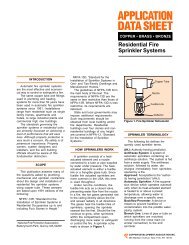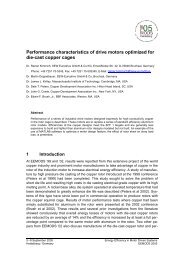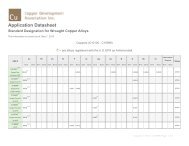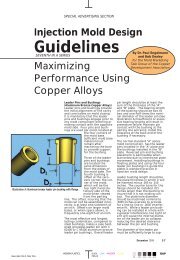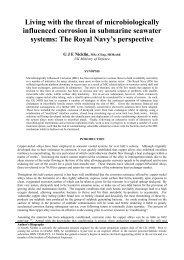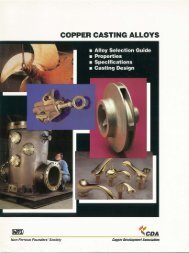Corrosion behaviour of copper alloys in natural sea water and ...
Corrosion behaviour of copper alloys in natural sea water and ...
Corrosion behaviour of copper alloys in natural sea water and ...
- No tags were found...
You also want an ePaper? Increase the reach of your titles
YUMPU automatically turns print PDFs into web optimized ePapers that Google loves.
<strong>Corrosion</strong> test<strong>in</strong>gEoc <strong>and</strong> Rp measurementsEoc <strong>and</strong> Rp measurements were conducted on specimens mach<strong>in</strong>ed from bars with a flagshape to enable electric connection out <strong>of</strong> them <strong>sea</strong> <strong>water</strong>, the dimensions be<strong>in</strong>g <strong>of</strong> 25 mm <strong>in</strong>length <strong>and</strong> 25 mm <strong>in</strong> width. Eoc was measured with respect to Saturated Calomel referenceElectrode (SCE). Rp measurements were obta<strong>in</strong>ed with l<strong>in</strong>ear polarization data acquiredus<strong>in</strong>g a potentiostat by impos<strong>in</strong>g a small amplitude potential <strong>of</strong> 15 mV around Eoc. Thesweep rate was 0.05 mV/s. Rp was taken as the slope <strong>of</strong> the I= f(E) curve near Eoc.Triplicate specimens were weighted before immersion <strong>and</strong> after clean<strong>in</strong>g with descal<strong>in</strong>gsolvents. Comparisons were made <strong>in</strong> each case with control specimens. Weight lossmeasurements were used to estimate the corrosion rates <strong>in</strong> µm/year. Specimen exam<strong>in</strong>ationwas conducted before <strong>and</strong> after clean<strong>in</strong>g. Tests were conducted <strong>in</strong> <strong>natural</strong> <strong>sea</strong> <strong>water</strong> dur<strong>in</strong>gabout 3 months but also <strong>in</strong> polluted <strong>sea</strong> <strong>water</strong> with sulphides or ammonia. Sea <strong>water</strong>pollution was simulated through Na 2 S addition <strong>of</strong> 10 ppm S 2- , <strong>in</strong> quiescent <strong>sea</strong> <strong>water</strong>(Contact time 30 m<strong>in</strong> before recirculation) every day dur<strong>in</strong>g 5 days. The results obta<strong>in</strong>ed <strong>in</strong>non polluted circulat<strong>in</strong>g <strong>sea</strong> <strong>water</strong> were compared to those <strong>in</strong> polluted <strong>sea</strong> <strong>water</strong> after about3 months <strong>of</strong> test. Ammonia additions were considered as another possible pollution that canbe encountered <strong>in</strong> stagnant conditions due to organic matter degradation. NH 4 OH was thenadded to stagnant <strong>sea</strong> <strong>water</strong> up to 1700 ppm <strong>of</strong> NH 3 , renewed every 2 weeks dur<strong>in</strong>g morethan one month. The results obta<strong>in</strong>ed <strong>in</strong> stagnant <strong>sea</strong> <strong>water</strong> renewed every 2 weeks werecompared to those <strong>in</strong> stagnant <strong>sea</strong> <strong>water</strong> polluted with ammonia.Polarization curvesThe anodic polarization curves were generated us<strong>in</strong>g a potentiostat, at a scan rate <strong>of</strong> 0.05mV/s, from Eoc to 0.3 V vs. SCE. The tests were conducted on “flag specimen” <strong>of</strong> 25 mm<strong>in</strong> length <strong>and</strong> 25 mm <strong>in</strong> width. Conditions <strong>of</strong> tests were the same as those selected for Eocmeasurements.Static crevice corrosion testsThe crevice device, shown <strong>in</strong> fig 1, was used <strong>in</strong> order to simulate metal /gasket <strong>in</strong>terfacessuch as flanges assembly under static conditions. The gaskets were aramid fiber gaskets <strong>and</strong>the assemblies were tightened to a controlled torque <strong>of</strong> 25 N.m lead<strong>in</strong>g to a pressure about20 N/mm 2 . It was lower than <strong>in</strong> service pressure but considered as a significant condition.One <strong>of</strong> the metallic surface was enlarged to enable crevice <strong>in</strong>itiation out <strong>of</strong> the <strong>in</strong>terface as itwas generally observed <strong>in</strong> service. Potentiostatic tests, at ambient temperature, wereconducted dur<strong>in</strong>g 73 days <strong>in</strong> circulat<strong>in</strong>g <strong>natural</strong> <strong>sea</strong> <strong>water</strong> under an imposed potential chosenclose to the Eoc measured.Crevice corrosion tests under frett<strong>in</strong>gAssemblies used for crevice corrosion test<strong>in</strong>g assisted by frett<strong>in</strong>g consisted <strong>of</strong> threespecimens with cyl<strong>in</strong>drical bosses fastened through their central hole with a controlledpressure <strong>of</strong> 2 N/mm 2 as shown <strong>in</strong> figure 2. The tests were performed <strong>in</strong> <strong>natural</strong> <strong>sea</strong> <strong>water</strong> at acontrolled temperature <strong>of</strong> 25°C. Micro–displacements <strong>of</strong> 10 microns were generated at afrequency <strong>of</strong> 10 Hz for 2 or 3 hours. Potentiostatic tests were conducted <strong>in</strong>creas<strong>in</strong>g thepotential step by step. The first phase consist <strong>of</strong> wait<strong>in</strong>g for steady current close to Eocpotential, then implement<strong>in</strong>g a frett<strong>in</strong>g sequence <strong>and</strong> record<strong>in</strong>g the correspond<strong>in</strong>g current.Then, potential was <strong>in</strong>creased <strong>and</strong> the frett<strong>in</strong>g sequence implemented. This step wasrepeated until the current reached 10 -4 to 10 -3 Amps.3



